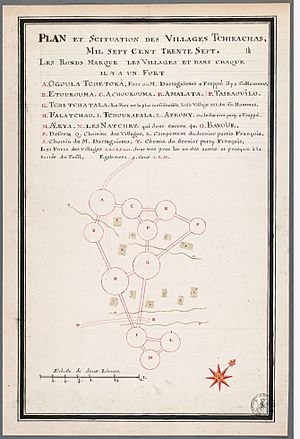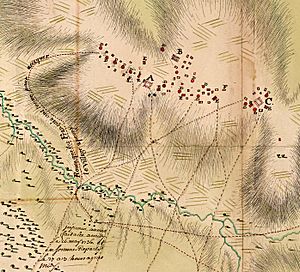Chickasaw Campaign of 1736 facts for kids
Quick facts for kids Battle of Ogoula Tchetoka |
|||||||
|---|---|---|---|---|---|---|---|
| Part of the Chickasaw Wars | |||||||
|
|||||||
| Belligerents | |||||||
| Chickasaw nation | France | ||||||
| Commanders and leaders | |||||||
| Mingo Ouma | Pierre d'Artaguette | ||||||
| Strength | |||||||
| perhaps 200 Chickasaw, and some Natchez warriors, a few English fur traders | 130 French regulars and militia, of which 30 were left behind to guard supplies; 38 Iroquois; 28 Arkansas; and 300 Miami and Illinois warriors | ||||||
| Casualties and losses | |||||||
| Reportedly 50 casualties | Most of the French killed or captured, Iroquois and Arkansas heavily engaged | ||||||
| Battle of Ackia | |||||||
|---|---|---|---|---|---|---|---|
| Part of the Chickasaw Wars | |||||||
|
|||||||
| Belligerents | |||||||
| Chickasaw nation | French in Lower Louisiana | ||||||
| Commanders and leaders | |||||||
| Mingo Ouma | Sieur de Bienville | ||||||
| Strength | |||||||
| Reportedly 100 Chickasaw warriors, roughly two dozen Englishmen, all within fortifications | 544 European regulars and militia excluding officers, 45 Africans, 600 Choctaw warriors | ||||||
| Casualties and losses | |||||||
| very few | Roughly 100 French killed, 100 French wounded, at least 22 Choctaw killed | ||||||
The Chickasaw Campaign of 1736 was a major event in the Chickasaw Wars. It involved two big battles where the French and their allies fought against the Chickasaw people. These battles took place in what is now Northeast Mississippi.
The French governor of Louisiana, Jean-Baptiste Le Moyne de Bienville, led this campaign. One French army from the north attacked a village called Ogoula Tchetoka on March 25, 1736. Another larger French army from the south attacked Ackia on May 26, 1736. In both battles, the Chickasaw successfully defended their homes.
Contents
Why the French Attacked the Chickasaw
The French empire in North America, called New France, stretched from New Orleans in the south all the way to Canada in the north. However, two Native American groups, the Natchez and the Chickasaw, lived in the middle of this territory. They made it hard for the French to travel freely along the Mississippi River.
The French had been fighting the Natchez people since 1716, often with the help of the Choctaw tribe. By 1736, many Natchez had been killed or scattered, and some found safety with the Chickasaw. Governor Bienville wanted to defeat these remaining Natchez and also weaken the Chickasaw. He believed a strong attack was needed to make the Native American tribes respect the French.
Bienville planned for two French armies to attack at the same time. One army, from the northern part of Louisiana, would be led by Pierre d'Artaguette. The other, larger army, from southern Louisiana, would be led by Bienville himself. They planned to meet near the Chickasaw villages on March 31, 1736.
Battle of Ogoula Tchetoka
Pierre d'Artaguette gathered his soldiers at Fort de Chartres in the Illinois Country. He quickly marched south to Chickasaw Bluff, which is now Memphis. He was supposed to meet other French groups, but they didn't show up.
D'Artaguette continued his march with his allies, including Chicagou and de Vincennes. He then received a message that Bienville's southern army was running late. D'Artaguette decided to attack on his own.
On March 25, 1736, d'Artaguette's force arrived at a village called Ogoula Tchetoka. This village was part of a larger area known as Chuckalissa or Old Town, near present-day northwest Tupelo, Mississippi. D'Artaguette had 130 French soldiers and 366 Native American warriors from the Iroquois, Arkansas, Miami, and Illinois tribes. He left 30 French soldiers behind to guard supplies.
D'Artaguette's northern force attacked with great energy. However, the Chickasaw fought back fiercely. The French were pushed back and chased away. Their valuable supplies, including gunpowder, were captured. Many French soldiers were killed or captured. According to French reports, 21 Frenchmen were captured. Nineteen of them, including d'Artaguette (who was wounded three times), were executed by burning. Two Frenchmen were kept alive, hoping they could be traded for a captured Chickasaw chief. They were later sent to the British in South Carolina.
Battle of Ackia
The southern French army attacked Ackia, which is in present-day south Tupelo, Mississippi. Governor Bienville's army, made up of French soldiers, Swiss guards, and militia, gathered in Mobile in March 1736. They traveled by boat up the Tombigbee River.
On April 23, the army reached their supply base at Fort Tombecbe. Here, they had 544 European soldiers and 45 African men. They were then joined by 600 Choctaw warriors. On May 4, the combined army continued upriver. They reached the area near present-day Amory, Mississippi, on May 22. They quickly built a camp to protect their supplies and boats. On May 24, they marched about 20 miles to the nearest Chickasaw village.
On May 26, the army approached three fortified villages: Ackia, Tchoukafalaya, and Apeony. These were together known as Long Town. As they got closer, they saw a British flag flying over one of the villages. They also saw several Englishmen among the Chickasaw. Bienville's nephew, Chevalier de Noyan, wanted to attack right away.
The French attacked Ackia, using large shields called mantelets for cover. But the Chickasaw fired a "shower of balls" from their defenses, and the shields didn't work well. The French attack got stuck on the side of the hill, and more and more soldiers were wounded or killed. They managed to take a few small cabins outside the main fort. But after several hours of fighting, the French had to retreat. They couldn't break through the Chickasaw defenses.
During the night, the Chickasaw improved their defenses by clearing away nearby cabins and plants. The French were running low on ammunition and food. They also worried about carrying their wounded soldiers. With no news from d'Artaguette's northern army, Bienville decided to retreat. The French lost about 200 men (100 killed and 100 wounded) in this unsuccessful battle.
What Happened Next
Historians have criticized the French campaign. They say Bienville attacked without proper tools for a siege. He also didn't try to contact d'Artaguette or get information about his army. He just retreated.
A Choctaw chief named Red Shoes reportedly said that the French didn't know how to fight. He said they could only take a small village of 30 or 40 men. Meanwhile, the French lost many men without killing many Chickasaw. He also noted that the French soldiers, wearing heavy clothes, marched too slowly and too close together. This made it easy for the Chickasaw to hit them.
The Chickasaw had good weapons from the English. They traded with English settlements in South Carolina and Georgia. Their forts were strong, with rectangular walls and round houses that had holes for shooting. With these defenses, the Chickasaw successfully protected their homeland. They faced constant pressure from the French and Choctaw, including another French campaign in 1739 and many small attacks for the next 20 years.
A place once thought to be the site of the Battle of Ackia became a U.S. National Monument in 1938. However, a few years later, the National Park Service realized the actual battle site was elsewhere. The monument was then made part of the Natchez Trace Parkway in 1961 and is now called 'Chickasaw Village.' Later research showed that the real site of Ackia and its nearby villages is in a developed area of south Tupelo. A neighborhood called 'Lee Acres' now covers the area where the 1736 Battle of Ackia took place. This battle was a key moment where the French failed to expand their territory in the Southeast.
See also
 In Spanish: Batalla de Ackia para niños
In Spanish: Batalla de Ackia para niños



